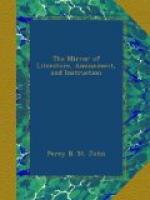Calais will merit to be described by every Englishman who visits it, and to be read of by every one who does not—so long as Hogarth, and “Oh! the Roast Beef of Old England!” shall be remembered, and—which will be longer still—till the French and English become one people, merely by dint of living, within three hours’ journey of each other. Calais has been treated much too cavalierly by the flocks of English, who owe to it their first, and consequently most fixed impressions of French manners, and the English want of them. Calais is, in fact, one of the most agreeable and characteristic little towns in France. It is “lively, audible, and full of vent”—as gay as a fair, and as busy as a bee-hive—and its form and construction as compact.
Calais, unlike any English town you could name, is content to remain where it is—instead of perpetually trying to stretch away towards Paris, as our’s do towards London, and as London itself does towards them. Transporting you at once to the “Place” in the centre of the town (an entirely open square, of about 150 paces by 100,) you can scarcely look upon a more lively and stirring scene. The houses and their shops (they have all shops) are like nothing so much as so many scenes in a pantomime—so fancifully and variously are they filled, so brightly and fantastically painted, and so abruptly do they seem to have risen out of the ground! This last appearance is caused by the absence of a foot-path, and of areas, porticoes, railings, &c.—such as, in all cases, give a kind of finish to the look of our houses. The houses here seem all to have grown up out of the ground—not to have been built upon it. This is what gives to them their most striking effect of novelty at the first view. Their brilliant and various colourings—so unlike our sombre brick-work—is the next cause of the novel impression they produce. The general strangeness of the effect is completed by the excellence of the pavement, which is of stones, shaped like those of our best London carriage-ways, but as white as marble in all weathers, and as regular as the brick-work of a house-front. The uniformity of the “Place” is broken (not very agreeably) by the principal public edifice of Calais—the Town Hall; a half-modern, half-antique building, which occupies about a third of the south side, and is surmounted at one end by a light spiring belfry, containing a most loquacious ring of bells, which take up a somewhat unreasonable proportion of every quarter of an hour in announcing its arrival; and, in addition, every three hours they play “Le petit chaperon rouge” for a longer period than (I should imagine) even French patience and leisure can afford to listen to it. Immediately behind the centre of this side of the “Place” also rises the lofty tower, which serves as a light-house to the coast and harbour, and which at night displays its well-known revolving lights. Most of the principal streets run out of this great Square.




